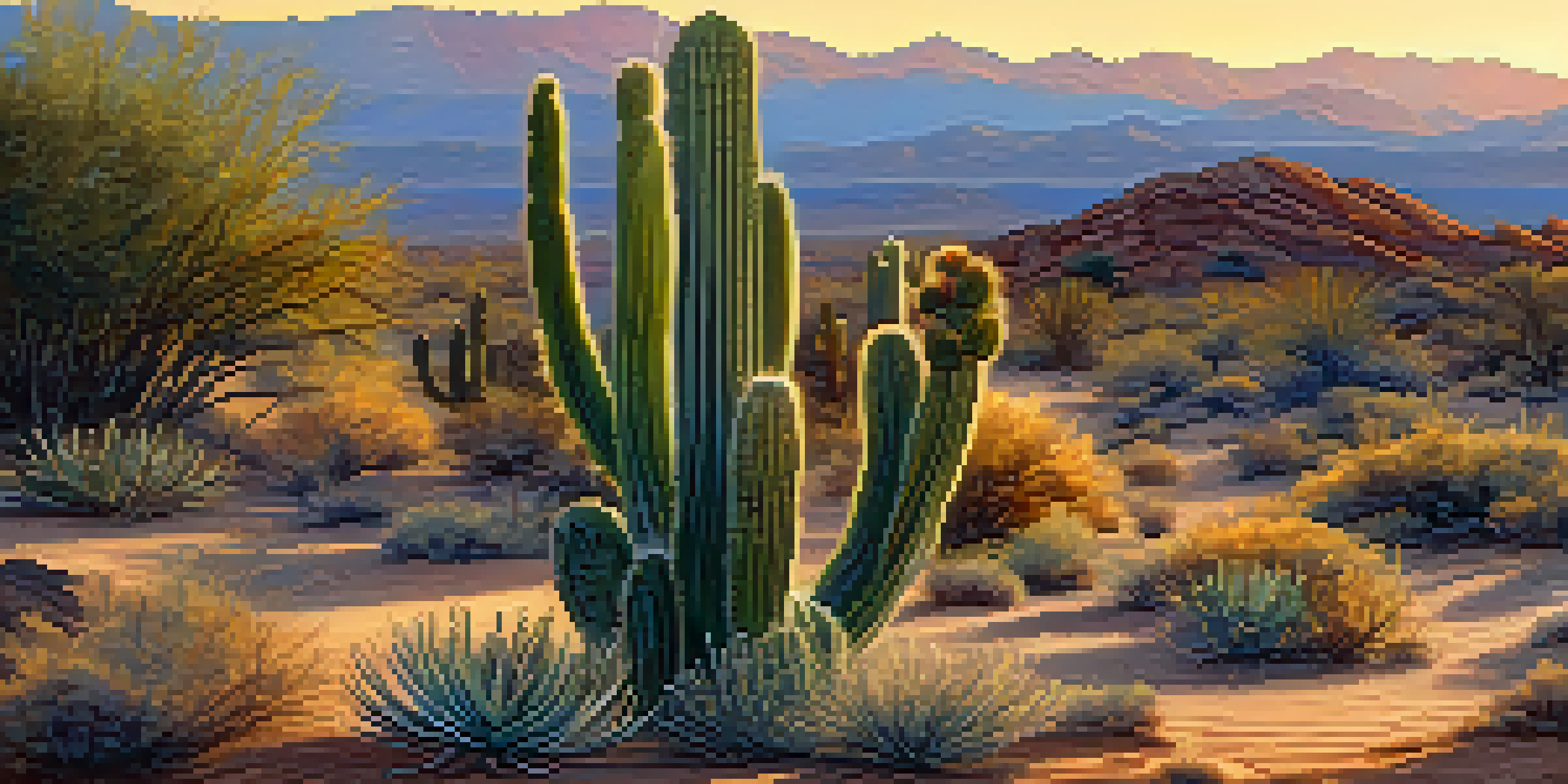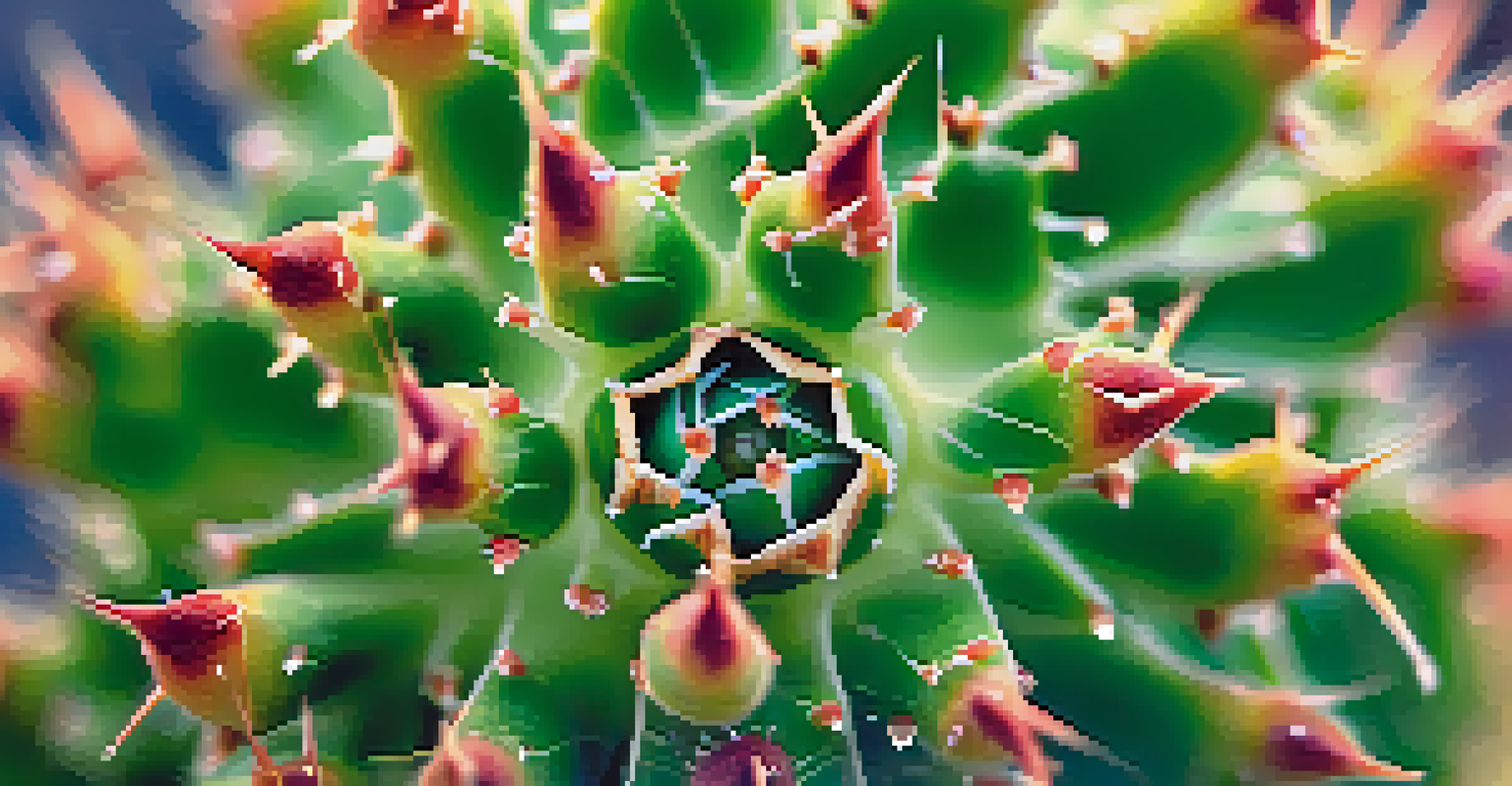The Intersection of Peyote Use and Environmental Activism

Understanding Peyote: A Plant with Cultural Significance
Peyote, a small cactus native to Mexico and the southwestern United States, has been used for centuries in various indigenous cultures, primarily for its psychoactive properties. This sacred plant holds deep spiritual significance, often serving as a tool for healing and introspection. For many Native American communities, peyote is not just a substance; it's a vital part of their cultural identity and traditions.
The land is sacred. It is not ours; it belongs to the future generations.
The use of peyote is often intertwined with rituals and ceremonies, emphasizing a connection to nature and the environment. These practices highlight the importance of sustainability and respect for the land, as the plants are considered gifts that should be treated with care. This perspective fosters a sense of responsibility among users, encouraging them to advocate for the preservation of natural habitats.
As awareness grows about the environmental challenges facing peyote habitats, many users are becoming vocal advocates for conservation. This relationship between peyote and environmental activism reveals how cultural practices can inspire a deeper appreciation for the earth and its ecosystems, creating a bridge between spiritual experiences and ecological stewardship.
The Role of Environmental Activism in Indigenous Communities
Indigenous communities often lead the charge in environmental activism, driven by a profound connection to their ancestral lands. For these groups, protecting the environment is not just about conservation; it is a matter of cultural survival and identity. Many indigenous activists argue that the health of the land directly affects their way of life, making their fight for sustainability deeply personal.

The challenges posed by climate change, deforestation, and land exploitation have led many to mobilize, using their cultural practices as a foundation for activism. By integrating peyote use into their efforts, these communities can draw on their spiritual traditions to inspire broader participation in environmental movements. This unique combination of cultural heritage and activism can amplify their voices in the fight for environmental justice.
Peyote's Cultural Significance
Peyote serves as a vital spiritual tool for many indigenous communities, fostering healing and introspection while emphasizing their cultural identity.
Moreover, these indigenous activists often emphasize the importance of preserving peyote habitats as a way to protect their cultural practices. By advocating for land conservation, they not only safeguard the plant but also ensure that future generations can continue to engage in their spiritual traditions. This creates a holistic approach to activism, where environmental and cultural preservation go hand in hand.
Challenges Facing Peyote Populations and Their Habitats
Despite its cultural significance, peyote is facing numerous threats, primarily due to habitat loss and overharvesting. As urbanization and agriculture encroach upon its natural environment, the populations of this sacred cactus are dwindling. This has raised alarm bells among indigenous communities and environmentalists alike, who recognize the urgent need for conservation efforts.
We do not inherit the earth from our ancestors; we borrow it from our children.
Additionally, the growing popularity of peyote among non-indigenous users has led to increased demand, further straining its populations. Many users may not be aware of the ecological impact of their consumption, which can lead to unsustainable harvesting practices. To address these concerns, education and awareness are crucial in promoting responsible use and supporting conservation initiatives.
Conservation efforts are underway, but they require collaboration between indigenous communities, environmental organizations, and policymakers. By working together, they can develop sustainable harvesting practices and create protected areas to preserve peyote habitats. This collaboration can serve as a model for other conservation efforts, highlighting the importance of inclusive approaches that respect traditional knowledge and cultural practices.
The Spiritual Connection: Peyote and Nature
For many peyote users, the experience is deeply spiritual, often leading to profound insights about the self and the interconnectedness of all living things. This spiritual connection fosters a sense of reverence for nature, encouraging individuals to take action to protect the environment. Users often report feeling a heightened sense of awareness and responsibility towards the earth, which can translate into advocacy efforts.
The rituals surrounding peyote consumption emphasize mindfulness and respect for the natural world. Participants are encouraged to reflect on their relationship with the environment, which can ignite a passion for environmental activism. This spiritual lens can inspire individuals to translate their insights into tangible actions, whether through community organizing or personal lifestyle changes.
Advocacy for Environmental Justice
Indigenous activists leverage their cultural practices, including peyote use, to inspire broader participation in environmental conservation efforts.
As these personal transformations occur, they can lead to broader cultural shifts within communities. The more individuals engage with their spiritual practices, the more likely they are to advocate for policies that protect the environment. This interplay between spirituality and activism illustrates how peyote use can be a catalyst for environmental consciousness.
Advocacy and Education: Spreading Awareness
Advocacy plays a crucial role in addressing the challenges facing peyote and its habitats. Many indigenous leaders and environmental activists are working to raise awareness about the importance of protecting this sacred plant. Through workshops, seminars, and social media campaigns, they are educating both indigenous and non-indigenous communities about sustainable practices and the ecological significance of peyote.
In addition to grassroots efforts, there are also initiatives aimed at influencing policy. Advocates are collaborating with lawmakers to promote legislation that protects peyote habitats and supports sustainable harvesting practices. By bridging the gap between cultural practices and environmental policy, they are creating a comprehensive approach to advocacy.
Education is key, not only for the preservation of peyote but also for fostering a broader understanding of indigenous rights and environmental justice. As more people learn about the significance of peyote and its challenges, they can become allies in the fight for conservation. This collective effort can help to invigorate both the peyote community and environmental movements.
The Future of Peyote and Environmental Activism
The future of peyote and its connection to environmental activism hinges on collaboration and education. As awareness grows about the challenges facing this sacred plant, there is an opportunity for individuals and organizations to come together for a common cause. By fostering partnerships between indigenous communities and environmental groups, we can create a robust network dedicated to the preservation of peyote and its habitats.
Moreover, as society becomes more attuned to the importance of sustainability, we are likely to see an increase in support for initiatives that protect peyote. This cultural shift could lead to greater appreciation for indigenous knowledge and practices, paving the way for more inclusive approaches to environmental activism. The intertwining of peyote use and environmental stewardship highlights the potential for a more harmonious relationship with nature.
Challenges and Conservation Efforts
Peyote populations face threats from habitat loss and overharvesting, prompting urgent calls for sustainable practices and collaborative conservation initiatives.
Ultimately, the future of peyote is not just about the plant itself but about the values it represents. By championing the interconnectedness of all living things and the importance of cultural heritage, we can inspire a new generation of environmental activists. This vision embraces both spirituality and sustainability, creating a path forward that honors the past while safeguarding the future.
Conclusion: A Call for Collective Action
The intersection of peyote use and environmental activism serves as a powerful reminder of the importance of cultural preservation and ecological responsibility. As we navigate the complexities of modern life, it is crucial to recognize the wisdom embedded in indigenous practices and the lessons they offer for environmental stewardship. The relationship between peyote and activism is a testament to the resilience of communities committed to protecting their heritage and the planet.
Collective action is essential in addressing the challenges facing peyote and its habitats. By supporting indigenous rights and advocating for sustainable practices, we can contribute to a more equitable future for all. Whether through education, activism, or personal lifestyle changes, every effort counts in this shared journey toward conservation.

As we reflect on the significance of peyote, let us remember its role as a spiritual guide and a symbol of our interconnectedness with the earth. Together, we can honor this sacred plant by committing to its protection and embracing the call for a more sustainable world. The future of both peyote and our planet depends on our actions today.